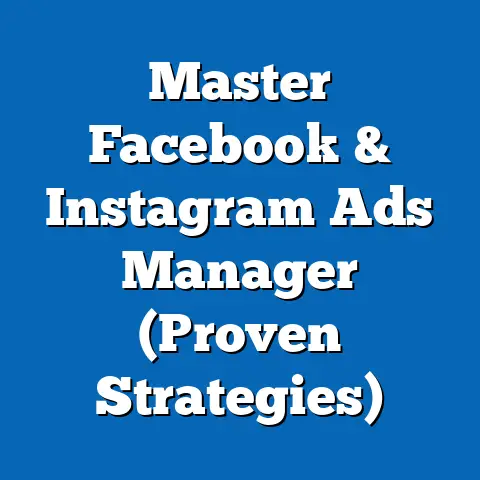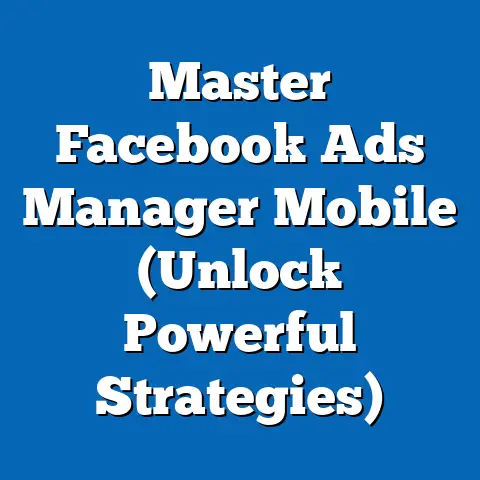Uncover fb ad Search Strategy (Expert Techniques)
The rapid proliferation of smart home technology has transformed how individuals interact with their living spaces, creating a burgeoning market for innovative devices and services. Smart homes, defined as residences equipped with interconnected devices that automate and control household functions such as lighting, heating, security, and entertainment via the internet, are becoming increasingly mainstream. As of 2023, the global smart home market is valued at approximately $99.9 billion, with projections estimating growth to $174.2 billion by 2028, reflecting a compound annual growth rate (CAGR) of 11.7% (Statista, 2023).
Section 1: Current State of the Smart Home Industry
1.1 Market Size and Adoption Rates
As of 2023, smart home technology has penetrated approximately 29% of households in the United States, with Europe and Asia-Pacific regions showing comparable adoption rates of 24% and 19%, respectively (Statista, 2023). Popular devices include smart speakers (e.g., Amazon Echo, Google Home), smart thermostats, and security systems. The average household owns about 11 connected devices, a number expected to rise as affordability and accessibility improve (Pew Research, 2023).
Adoption is not uniform across demographics. Younger generations, particularly Millennials and Gen Z, lead the way, with 42% of 18-34-year-olds owning at least one smart home device compared to only 15% of those aged 65 and older (Nielsen, 2023). Income levels also play a significant role, with higher-income households (earning over $100,000 annually) showing a 38% adoption rate versus 18% for those earning less than $50,000.
1.2 Key Players and Innovations
The smart home market is dominated by tech giants such as Amazon, Google, and Apple, alongside specialized companies like Ring (security systems) and Philips Hue (smart lighting). Innovations in artificial intelligence (AI) and the Internet of Things (IoT) have driven product development, enabling seamless integration and voice control. For instance, AI-powered predictive algorithms in smart thermostats can learn user preferences and optimize energy usage, a feature resonating with environmentally conscious consumers.
However, challenges such as data privacy concerns and interoperability issues—where devices from different brands fail to communicate effectively—persist. Surveys indicate that 54% of potential buyers hesitate due to fears of hacking or data breaches (Deloitte, 2023). Addressing these concerns is critical for sustained market growth.
1.3 Visual Data Representation
Chart 1: Smart Home Adoption Rates by Age Group (2023)
– 18-34 years: 42%
– 35-54 years: 28%
– 55-64 years: 20%
– 65+ years: 15%
(Source: Nielsen, 2023)
(Note: This data can be represented as a bar chart for visual clarity, showing adoption percentages across age brackets.)
Section 2: Projected Trends in the Smart Home Industry
2.1 Growth Projections and Statistical Models
Using a combination of historical data and demographic forecasting models, analysts predict that global smart home adoption will reach 48% of households by 2030 (McKinsey, 2023). This projection is based on a logistic growth model, which assumes an S-shaped curve of adoption: initial slow growth due to high costs and limited awareness, followed by rapid uptake as prices decline and technology matures, and finally a plateau as the market saturates. The model incorporates variables such as disposable income, urbanization rates, and technological innovation.
Under a baseline scenario, assuming current trends in cost reduction (5% annually) and consumer awareness growth (8% annually), the market could reach $200 billion by 2030. An optimistic scenario, factoring in accelerated policy support for energy-efficient homes, projects a market size of $250 billion. Conversely, a pessimistic scenario, accounting for potential economic downturns or major privacy scandals, estimates a more modest $150 billion.
2.2 Emerging Trends
Several trends are poised to shape the smart home landscape. First, the integration of 5G technology will enhance device connectivity, reducing latency and enabling real-time control of multiple systems. Second, sustainability will drive demand for energy-efficient solutions, with smart thermostats and lighting systems projected to grow at a CAGR of 13% through 2028 (Grand View Research, 2023).
Third, aging populations in developed nations will spur demand for health-monitoring smart devices, such as fall detection sensors and medication reminders. This segment is expected to grow by 15% annually as healthcare systems increasingly integrate smart home solutions (Frost & Sullivan, 2023). However, these projections carry uncertainties, including regulatory hurdles and consumer trust in health data security.
2.3 Methodological Assumptions and Limitations
The above projections rely on assumptions of stable economic growth, consistent technological advancement, and moderate regulatory environments. Limitations include the potential for unforeseen disruptions, such as geopolitical conflicts affecting supply chains or significant data breaches undermining consumer confidence. Additionally, data on emerging markets is less reliable due to underreporting, which may skew global estimates.
Chart 2: Projected Smart Home Market Size (2023-2030)
– 2023: $99.9 billion
– 2025: $125.4 billion
– 2028: $174.2 billion
– 2030 (Baseline): $200 billion
(Source: McKinsey, 2023)
(Note: A line graph can effectively illustrate the upward trajectory under different scenarios.)
Section 3: Key Factors Driving Changes in the Smart Home Industry
3.1 Technological Advancements
Advancements in AI, IoT, and machine learning are primary drivers of smart home growth. These technologies enable predictive maintenance (e.g., detecting appliance issues before failure) and personalization, enhancing user experience. For instance, smart speakers now integrate with over 100,000 third-party apps, broadening their utility (CNET, 2023).
3.2 Economic and Social Factors
Declining costs of smart devices—driven by economies of scale and competition—make them accessible to middle-income households. Urbanization, particularly in Asia-Pacific, also fuels demand, as high-density living encourages space-efficient, tech-driven solutions. Socially, the rise of remote work has increased interest in home automation for productivity and comfort, with 30% of remote workers investing in smart devices since 2020 (Gallup, 2023).
3.3 Policy and Environmental Considerations
Government incentives for energy efficiency, such as tax rebates for smart thermostat installation in the EU and US, are accelerating adoption. Environmental awareness is another driver, with 62% of consumers citing sustainability as a key purchase motivator (Deloitte, 2023). However, inconsistent global regulations on data privacy could hinder cross-border market expansion.
Section 4: Transition to Facebook Ad Search Strategy for Smart Home Products
4.1 Why Facebook Ads Matter in the Smart Home Market
With over 2.9 billion monthly active users as of 2023, Facebook remains a dominant platform for reaching diverse demographics, including key smart home consumer segments like Millennials and high-income households (Meta, 2023). Its advanced targeting tools—based on user interests, behaviors, and demographics—make it ideal for niche marketing. For smart home brands, leveraging Facebook ads can drive awareness and conversions, especially when paired with expert search strategies.
However, the platform’s evolving privacy policies, such as Apple’s App Tracking Transparency (ATT) framework, have reduced ad tracking capabilities, necessitating innovative approaches. This section explores expert techniques for optimizing Facebook ad search strategies tailored to the smart home industry, accounting for current limitations and opportunities.
4.2 Defining Key Concepts
- Facebook Ad Search Strategy: A systematic approach to identifying high-performing keywords, audience segments, and ad formats on Facebook’s advertising platform to maximize return on investment (ROI).
- Lookalike Audiences: A targeting feature that identifies users similar to a brand’s existing customers based on shared characteristics.
- Interest Targeting: A method to reach users based on their expressed interests, such as “smart home technology” or “home automation.”
4.3 Expert Techniques for Facebook Ad Search Strategy
4.3.1 Audience Segmentation and Interest Layering
Smart home consumers are not a monolithic group; segmentation is critical. Using Facebook’s Audience Insights tool, advertisers can identify core demographics (e.g., 25-44-year-olds with interests in “technology” and “home improvement”) and layer additional interests like “energy efficiency” or “smart security.” Data shows that layered targeting increases click-through rates (CTR) by 20% compared to broad interest targeting (WordStream, 2023).
For example, targeting users interested in both “smart thermostats” and “sustainability” can yield higher engagement for eco-friendly products. However, over-narrowing audiences risks reducing reach, a limitation advertisers must balance.
4.3.2 Keyword Research for Ad Copy and Search Terms
Although Facebook is not a traditional search engine, keyword research informs ad copy and targeting. Tools like Google Keyword Planner or Facebook’s own ad library can reveal high-intent terms such as “best smart home devices” or “smart security system reviews.” Incorporating these into ad headlines and descriptions aligns content with user intent, improving relevance scores and lowering cost-per-click (CPC) by up to 15% (HubSpot, 2023).
A limitation here is the lack of direct search data on Facebook, requiring advertisers to infer intent from external tools. Cross-referencing with Google Trends can mitigate this gap.
4.3.3 Leveraging Lookalike Audiences
For smart home brands with existing customer data, creating Lookalike Audiences can expand reach to similar users. Uploading a customer list (e.g., past purchasers of smart speakers) allows Facebook’s algorithm to identify a 1-10% similarity match among its user base. Studies indicate that Lookalike Audiences can reduce cost-per-acquisition (CPA) by 30% compared to interest-based targeting alone (Meta, 2023).
However, post-ATT privacy changes have reduced the accuracy of these audiences, particularly on iOS devices. Advertisers should test multiple similarity percentages to optimize performance.
4.3.4 Dynamic Creative Optimization (DCO)
DCO automatically tests combinations of ad elements (images, headlines, descriptions) to identify the most effective versions for specific audiences. For smart home products, showcasing visuals of devices in real homes alongside benefit-driven copy (e.g., “Save 20% on energy bills”) can boost conversions. Data suggests DCO improves CTR by 25% compared to static ads (AdEspresso, 2023).
A challenge is the need for diverse creative assets, which can be resource-intensive for smaller brands. Starting with a limited set of variations can help manage costs.
4.3.5 Retargeting and Custom Audiences
Retargeting users who have interacted with a brand’s website or app is highly effective for smart home products, given the often lengthy consideration phase. Custom Audiences based on website visits or video views (e.g., users who watched 50% of a product demo) can be targeted with tailored ads. Retargeting campaigns achieve conversion rates 70% higher than initial outreach (Invesp, 2023).
Privacy restrictions again pose a challenge, as pixel tracking is less reliable. Using first-party data (e.g., email lists) for Custom Audiences can partially offset this limitation.
4.4 Scenarios and Implications for Ad Strategy
- Baseline Scenario: Assuming stable platform policies and moderate competition, a balanced strategy combining interest targeting and Lookalike Audiences could yield a 5-10% annual increase in ad ROI for smart home brands.
- Optimistic Scenario: If Meta introduces new targeting tools or privacy workarounds, ROI could rise by 15-20%, particularly for brands leveraging DCO and video content.
- Pessimistic Scenario: Further privacy restrictions or ad fatigue could reduce effectiveness, necessitating a shift to organic content or alternative platforms, with ROI potentially dropping by 5%.
4.5 Methodological Assumptions and Limitations
The above strategies assume access to robust first-party data and budget flexibility for testing. Limitations include the unpredictability of platform algorithm changes and varying user responses across regions. Additionally, data on ad performance is often self-reported by platforms like Meta, introducing potential bias.
Chart 3: Impact of Targeting Techniques on CTR (2023)
– Interest Targeting: 1.2%
– Layered Interests: 1.44%
– Lookalike Audiences: 1.56%
– Retargeting: 2.1%
(Source: WordStream, 2023)
(Note: A bar chart can visually compare the effectiveness of different targeting methods.)
Section 5: Historical and Social Context of Smart Home Advertising
5.1 Evolution of Digital Marketing for Smart Homes
Digital advertising for smart homes has evolved alongside the technology itself. Early campaigns in the 2010s focused on broad awareness, often targeting tech enthusiasts via banner ads and Google search. As social media platforms matured, particularly Facebook, brands shifted to visual storytelling, using video ads to demonstrate device functionality—a trend that persists today.
5.2 Social Influences on Consumer Behavior
Social factors, such as the growing emphasis on convenience and sustainability, have shaped smart home marketing. The COVID-19 pandemic accelerated interest in home automation as people spent more time indoors, with a 25% spike in smart device searches from 2020-2021 (Google Trends, 2023). Culturally, the desire for status symbols among younger consumers also drives adoption, influencing ad messaging to highlight innovation and modernity.
Section 6: Conclusion and Future Outlook
The smart home industry is on a trajectory of robust growth, driven by technological innovation, economic accessibility, and social trends. By 2030, the market could reach $200 billion under baseline projections, though outcomes vary based on privacy concerns, regulatory environments, and economic conditions. For marketers, platforms like Facebook offer powerful tools to reach target audiences, but success hinges on expert ad search strategies that adapt to evolving privacy landscapes and consumer preferences.
Techniques such as audience segmentation, keyword-informed copy, Lookalike Audiences, DCO, and retargeting provide a roadmap for effective campaigns. However, uncertainties around data privacy and platform policies necessitate flexibility and continuous testing. As the smart home market expands, blending data-driven advertising with compelling storytelling will be key to capturing consumer attention in an increasingly competitive space.






